|
|
Medicinal
Plants
|
Stevia ||
Safed Musli
|
|
|
ANNATTO
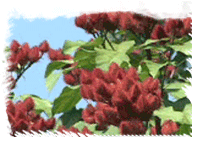 Annatto
is profusely fruiting shrub or small tree that grows 5-10 m in
height. Approximately 50 seeds grows inside reddish-orange
heart-shaped pods at the end of the branches. one small annatto
tree can produce upto 270 kg. of seeds which is the source of
orange-yellow dye. Annatto is known as Achiote in Spanish, Urucum
in Portuguese & Lipstick tree in English. Annatto
is profusely fruiting shrub or small tree that grows 5-10 m in
height. Approximately 50 seeds grows inside reddish-orange
heart-shaped pods at the end of the branches. one small annatto
tree can produce upto 270 kg. of seeds which is the source of
orange-yellow dye. Annatto is known as Achiote in Spanish, Urucum
in Portuguese & Lipstick tree in English.
ORIGIN
It grows
throughout South & Central America, Caribbean and can be found in
some parts of Mexico as well.
Nomenclature
Family
: Bixaceae
Genus : Bixa
Species : Orellana
USES
Used Plant Parts
: Seeds, Leaves, Bark, Roots, Shoots
Uses : As a dye
and coloring agent
Agroclimatic
Requirement for Annatto Cultivation : The plant is widely
cultivated and naturalized in tropical and subtropical regions of
the world.
Rainfall ranges from 1000 mm - 3000 mm per year in areas where the
species grows naturally or under cultivation. Soils with texture
from sandy to clay are colonized. The species is frost sensitive.
Cultivation
practices
Land Preparation
: Trenches of 10"x10" x 10" size are prepared at the distance of
10" x 10" to 10" x 15" for planting in the month of July-August.
Seeds: 200 plants
are required per Acre
|
|
|
|
ASHOKA
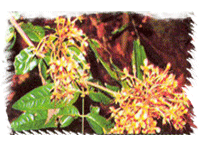 A
small evergreen tree 6 to 9 m high found wild along streams or in
shade of evergreen forests. Leaves pari-pinnate, 15-20 am long,
leaflets 6-12, oblong, lanceolate; flowers orange or orange-yellow
very fragrant; pods flat, leathery; seeds 4-8 ellipsoid-oblong. A
small evergreen tree 6 to 9 m high found wild along streams or in
shade of evergreen forests. Leaves pari-pinnate, 15-20 am long,
leaflets 6-12, oblong, lanceolate; flowers orange or orange-yellow
very fragrant; pods flat, leathery; seeds 4-8 ellipsoid-oblong.
Common Name :
Ashok, Sita Ashok.
DISTRIBUTION
Almost throughout India up to an
altitude of 720 m in the center and eastern Himalayas & Khasi,
Garo and Lushai hills. It is also found in the Andaman Islands.
Parts Used
: Stem Bark
CULTIVATION
Soil and Climate
The plant requires slightly acidic
to neutral soils for good growth with medium to deep well drained
fertile soils. It grows well in tropical to sub-tropical
situations under irrigation.
Nursery Raising and Planting
Seeds and stem grafting can
propagate the crop. The seedlings are planted in well-manured
field during the rainy season.
Thinning and weeding
Weeding and thinning of the plants
may be done and when required usually after 15-30 days for better
growth.
Manure
Compost / vermin compost, organic
manure is preferred.
Irrigation
Normally grown as rainfed crop but
for better yield irrigation may be done as per requirement
(weekly/fortnightly)
Harvesting/Post-Harvesting Operation
Bark is removed from about ten years
or older tree and then it has to be sun dried.
Economics
Input
Cost Rs. 5,500.00
Output Rs. 20,000.00
Uses
Leucorrhoea, Menorrhagia, fever,
burning sensation, uterine disease.
|
|
|
|
ASHWAGANDHA
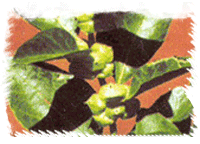 An
erect branched under shrub up to 2 feat in height root fleshy,
whitish brown : leaves ovate; flowers greenish. An
erect branched under shrub up to 2 feat in height root fleshy,
whitish brown : leaves ovate; flowers greenish.
Nomenclature
Family
- solanaceae
Genus - withania
Species - somnifera
Common names: - Ashwganda, asgandh, punir .
Distribution: - Rajasthan, Punjab, Haryana, U.P, M.P.
Parts used: Roots, Leaf, and Seeds.
USES
It can be used
for diseases like insomnia, weakness, ulcers.
Cultivation
practices
CULTIVATION
Soil and Climate: Grows well in sandy loam or light red soil. The
semitropical areas receiving 500-750 mm rainfall are suitable for
cultivation. The winter rains are conductive for the proper
development of the plant.
LAND PREPARATION
The soil of the field selected for Ashwgandha should used
pulverized by ploughing and harrowing.
NURSERY RAISING AND PLANTING
The crop can be soon either by broad costing or in lines. The
seeds are usually soon about 1-3 cm deep in June - July in
nursery. A light shower after sowing ensures good germination.
About 500 - 750 gm seeds are sufficient for one hectare. The
seedling after 25 - 35 days after sowing can be transplanted in
the field maintaining 60 x 60 cm spacing between the plants and
the rows.
THINNING AND WEEDING
Thinning and weeding should be done after 25 - 30 days are sowing.
MANURE
1 Quintal FYM per area.
IRRIGATION
Light shower after transplantation ensure establishment of
seedlings. There is no need of irrigation in rainfall at regular
intervals.
HARVESTING
The plants start flowering and bearing fruits from December on
wards. The crops is ready for harvest in January - march.
ECONOMICS PER
ACRE
|
Yield : On an
average yield from one acre land under commercial cultivation
is an approx. 2-3 quintals of dried roots and 30-40 kg seeds.
Cost of cultivation, yield and income per acre |
|
Items |
Cost (Rs.) |
|
Land
preparation and ploughing |
1,000.00 |
|
Cost of seeds
(5 kg) @ 50-60/kg |
300.00 |
|
Pesticides
etc. |
2,000.00 |
|
Weeding and
irrigation |
1,000.00 |
|
Harvesting of
seeds, digging of roots, cleaning, grading |
1,500.00 |
|
Packing
material |
500.00 |
|
Subtotal |
6,300.00 |
|
Contingencies
10% |
630.00 |
|
Total |
6,930 -
7000.00 |
|
Yield and
Income |
|
|
Roots (kg) |
300.00 |
|
@ 60 / Kg |
1,800.00 |
|
Seeds (Kg / @
50 / Kg) |
1,500.00 |
|
Total
Income |
19,500.00 |
|
Net
Income |
12,500.00 |
|
|
|
|
ATEES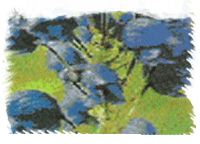
A herbaceous, erect,
biennial herb; leaves more or less hetero morphous; flower blue or
violet, fruits follicles. Root tuberous in pairs whitish or gray,
breaks very easily and taste very bitter. The plant is found in
sub- alpine and alpine zone of Himalayas, between 2400-3600 m.
Common names:
atyees, aruna, ativasa, visa.
Distribution
Hills of Himachal Pradesh,
Uttaranchal, Jammu & Kashmir, arunachal pradesh and sikkm.
Part used:
tuberous root
CULTIVATION
SOIL AND CLIMATE
Sandy loam and
acidic soil is best for seed germination, survival, better growth
and yield. In germination, cultivation up to 2500m elevation
having sandy textured soil with rich organic matter us recommended
for cultivation.
NURSERY RAISING AND
PLANTING
Germination of seeds
of aconitum heterophllum can be undertaken at lower altitude in
ployhouse as well as in open nursery beds under different
experimental conditions. Seeds sown in Styrofoam seedling trays
containing sandy soil with litter treatment, gives maximum
germinability when seeds were sown 0.5-0.7 cm. Sowing depth inside
polyhouse during November and December at lower altitude and
during April in open beds at 2200m. Germination as well as true
leaf initiation is earlier in sandy soil. Otherwise seedlings
remained in cotyledonary stage (pseudomonocotyl) up to 3-4 months.
About 44,000 plants could be planted in 1 acre of land. Seedlings
raised at lower altitude during winter months are transplanted in
nursery beds at higher altitude during April – May, which reduce
their vegetative growth period. In open nursery beds seed
germination is very slow growth and cotyledonary phase (pseudomonocotyl)
remained at least for one growth season (3-4 months). Vegetative
growth phase is for 3-4 years and at least it leads to
reproductive phase.
MANURE
2-3 q of farm Yard
Manure (FYM) is required for one acre of land.
Irrigation and Weed
Control
Beds needed
excessive watering/irrigation to decrease the mortality rate of
seedlings. However, watering is not required during monsoon period
in cultivated fields. Irrigation requirement also depends on the
texture of soil. Frequent watering is required once at 24hrs
interval for 6 months old seedlings at lower altitudes
(1800-2200m) in dry season. Weeding during rainy season is
required at weekly interval. During winter months irrigation is
needed once in a week to retain moisture and weeding at 15-20 days
interval is required when plant is cultivated at lower altitude.
YIELD
Per acre production
from mature strands is estimated as 100-150 kg.
Economics (Per
Acre-2002)
Input Cost
Rs. 35,000.00
Output
Rs. 1,00,000.00
Yield
1-1.5 q root
Note : Market for
medicinal plants is volatile and the economics may vary.
Uses
Dysentery, Diarrhea,
Fever, Vomiting, Children diseases. |
|
|
|
BAEL
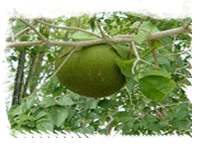 A
deciduous tree 6.0 to 10 m in height and 0.9 to 1.2 m in girth,
with straight, sharp, axillary thorns and trifoliate aromatic
leaves. The stem bark is bluish grey, 4-8 mm thick, shallowly
furrowed and corky. Flowers 3 cm in diameter, grayish-white, sweet
scented, stalked. Fruit large about 15 cm diameter, globose, ovoid
and 8-15 celled. A
deciduous tree 6.0 to 10 m in height and 0.9 to 1.2 m in girth,
with straight, sharp, axillary thorns and trifoliate aromatic
leaves. The stem bark is bluish grey, 4-8 mm thick, shallowly
furrowed and corky. Flowers 3 cm in diameter, grayish-white, sweet
scented, stalked. Fruit large about 15 cm diameter, globose, ovoid
and 8-15 celled.
DISTRIBUTION
The tree is a native of India and is
found wild throughout the Indian Peninsula, in dry hilly places
ascending to 1200 m in the western Himalaya.
CULTIVATION
Soil and Climate
Good sandy loam soil, sunny
situation, warm humid climate are suitable for cultivation of this
plant.
Nursery Raising and Planting
Seeds generally propagate bael
plants. Sowing is done in June or July. The development of
seedlings is very slow. They require at least one year in the
nursery to be fit for transplanting. They should be transplanted
in rainy season; the stem is ordinary 5-7 cm tall with 3-5 leaves
and the taproot, 20-25 cm long. It is also propagated by root
cuttings and stem cuttings treatment with IBA (4000 ppm) using
quick dip method. Seedlings or budded plants are transplanted in
the field at a spacing of 10-12 m. Budded plants start bearing
fruits at the age of 4-5 years, whereas seedling trees require 7-8
years.
Manure/ Thinning and Weeding
It requires attention during first
year when they are well manured and weeded after the rains.
Irrigation
The field after plantation should be
irrigated periodically as and when required weekly or fortnightly.
Yield
The average yield is 150-200 fruits
per tree. The quality of fruits is greatly associated with the
weight and size of the seed-sacs. The larger and heavier the seed
sacs, the greater is the amount of mucilage and poorer the
quality.
Economics
The rate for 1 kg of fruit pulp
ranges from Rs. 40-45.
Uses
Diarrhoea, Dysentery, Vomiting,
Diabetes, Pain in abdomen.
|
|
|
|
BHUMI AMALKI
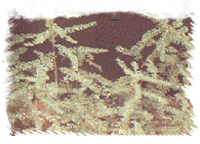 Small
erect annual herb 10-60 cm tall. Leaves small eliptic-oblong;
flowers, whitish-green & minute. Small
erect annual herb 10-60 cm tall. Leaves small eliptic-oblong;
flowers, whitish-green & minute.
Common Names:
Tamalaki,Hazaradana,Jarmala & jangli Amla.
Common Names:
pippali, pipli & long peper.
DISTRIBUTION
The plants grow undantly throughout India up to 700
m altitude during rainy season, however the less frequency in
southern part of the country. Uttar Pradesh, Haryana, Punjab,
Maharashtra, Tamil, Nadu, Kerala, Andra Prades, Karnataka, Bihar,
Orissa and Bengal.
Parts used:
Whole Plant.
CULTIVATION
Soil and climate
Bhumi Amalaki
is found to be well adapted to
variety of soils, at soil pH ranging from alkaline to natural and
acid soil. Plants have also shown preference for calcareous well
drained and light textured soils. Phyllanthus amarus is a
circum-tropical weed, it grows well under tropical conditions. It
, however rarely survives under dry or very low temperature
conditions but water logging does not show any lethal effects.
Nursery Raising & Transplanting
The plants are
propagated through seeds. About 1 Kg of seeds are sufficient for
seeding for transplanting in one hectare of land. For raising the
seeding, the seeds are shown in well prepared nursery beds. Well
decomposed Farmyard manure should be mixed with top layer of the
soil while preparing the beds. Being minute, the seeds are mixed
with dry soil or sand to allow uniform distribution of seeds on
the nursery bed. Later a thin layer of soil is spread to cover the
nursery beds . Appropriate moisture is maintained in the beds till
the seeds have germinated. In the north plains, the month of
April- May was found very good for higher rate if germination of
seeds and good herb yield.
Approximately 15-30 days old seedlings,
which are about 10 cm tall, are transplanted in the field at
horizontal and vertical spacing of 15 cm each. A proper
irrigation just after transplanting ensures establishment of
seedlings gives improved yield of herbage.
WEEDING
The field should
be kept absolutely free from weeds for which regular and weeding
in every month is required. Spraying of commercial herbicides are
not desirable, science, these causes deterioration to the crop and
also to avoid residual effect in the crude drug.
MANURE
Organic manures
are proffered. Farm Yard Manure (FYM), if applied in appropriate
quantities, when plants are about 30 cm in height, would render
better growth and higher herb yield.
IRRIGATION
In southern
parts of country, where there is frequent rainfall during rainy
season, no irrigation may be required. However, in Northern
plains, where there is in frequent rain fall, one irrigation per
fortnight is required. Water logging, fortunately is not a problem
for this plant.
HARVESTING/POST-HARVESTING
Plants are
harvested when the rainy season is over, when they are still green
and herbaceous. Science the active constituents of P. amarus
concentrate more in the leaves, production of higher leaf mass is
desired for the extraction. Plants in September contains highest
amount of leaves and found to be suitable for harvesting.
ECONOMICS
Input
Cost Rs. 2,000.00
Output
Cost Rs. 4,000.00
Yield
7 q herbage
USES
Jaundice,
Dropsy, Diarrhea, Dysentery, Wounds.
|
|
|
|
CHANDAN
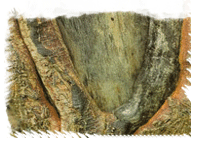 A
small evergreen tree, attaining a height of 12-13 m and girth of 1
to 2.4 m with slender druping as well as erect branching. The tree
starts flowering at an early age of 2 to 3 years. Fruit is drupe,
purplish when fully mature and single seeded. A
small evergreen tree, attaining a height of 12-13 m and girth of 1
to 2.4 m with slender druping as well as erect branching. The tree
starts flowering at an early age of 2 to 3 years. Fruit is drupe,
purplish when fully mature and single seeded.
COMMON NAMES:
Chandan, sandalwood, safed,
chandan, sandal, chandana.
DISTRIBUTION
It is distributed in the dry scrub
forest of salem, mysore, coorg, coimbatore, nilgiris up to 900 m.
altitude, also found in Andhra pradesh, Bihar, Gujarat, Karnataka,
Madhya pardesh, maharashtra and Tamil nadu.
Part used:
Heart wood.
CULTIVATION
Soil and Climate
Grows well in red sandy loam soil.
Crop requires humid&hot climate.
Nursery raising and planting
Two types of seeds beds are used to
raise sandal seedlings: sunken and raised beds. Both of them
perform equally well under different climatic conditions.
Seeds beds are formed with only sand
and red earth in the ratio 3:1 and are thoroughly mixed. Around
2.5 kg seed is spread uniformly over the bed, covered with straw,
which should be removed when the leaves start appearing on the
seedlings. Sandal suffers from a very virulent disease caused by
combined fungal and nematode infection.
When seedlings have reached 4 to
6leaf stage they are transplanted to poly bags along with a seed
of “tur dal” (cajanus cajan), the primary host for better growth
of sandal. Seedlings are carefully removed from beds with all
roots intact; roots should not be allowed to dry. Shade can be
provided for a week immediately after transplantation. Watering is
to be done once a day, but excess moisture is to be avoided. Host
plants are to be pruned frequently, so that they do not over grow
sandal and hamper its growth. Poly bags should contain soil
mixture of ratio 2:1:1 (sand: red earth: farm yard manure). It
has been found that poly bag of 30X14cm size are the best.
Plant able seedlings of about 30cm
height can be raised in 6-8 months’ time. A well- branched
seedling with a brown stem is ideal for planting in the field.
THENNING AND
WEEDING
Weeding is to be done at regular
intervals.
MANURE
20t farm-yard-manure (FYM)/hectare
is required for god growth.
IRRIGATION
It is a rain fed crop. Young plants
require watering in summer months at 15-20 days interval till they
are fully established.
HARVESTING/POST-POSTHARVESTING
OPERESTING
Sandal wood trees are harvested at
the age of 30-60 years. The soft wood is first removed; the hard
wood is chipped and then converted into power in a mill. The power
is soaked in water for 48 hours and then distillation takes place
in 48 hours. The oil is rectified and filtration.
YIELD
Sandal is considered to be a slow
growing tree. It grows at the rate of 5cm. of girth or more per
year under favorable soil and moisture conditions. The heartwood
formation starts around ten years of age. The following table
gives an idea of growth and development:
AVERAGE HEARTWOOD FORMATION PER TREE
|
Age (years) |
Girth at breast height cm |
Yield of heartwood in kg. |
|
10 |
10 |
1 |
|
20 |
22 |
4 |
|
30 |
33 |
10 |
|
40 |
44 |
20 |
|
50 |
55 |
30 |
ECONOMICS (PER ACRE-2002)
Input Cost (Rs.)
1,00,000
Output (Rs.)
4,50,000
Yield 1500 kgHW
USES
Vitated Condition of Pitta, Burning
sensation, Hyperacidity, Skin Diseases, Inflammations,
Leucorrhoea, Menorrhagia.
|
|
|
|
CHAIRAITA
 An
annual herb 30-80 am high; leaves lanceolate acute; flowers
greenish-purple. It grows naturally. Flowering and fruiting July
to September. An
annual herb 30-80 am high; leaves lanceolate acute; flowers
greenish-purple. It grows naturally. Flowering and fruiting July
to September.
Common names
: Chirayata, Kirata and Kirataka.
DISTRIBUTION
In temperate to sub-alpine Himalayan
areas from J&K, H.P., U.P. to Arunachal Pradesh on slopes between
1800-3600 m altitude, Himachal Pradesh, Uttranchal, Sikkin &
Arunachal Pradesh.
Parts Used
: Whole plant.
CULTIVATION
Soil and Climate
The plant can be grown in variety of
soils with sandy loam rich in carbon and humus. It can be grown in
sub-temperate regions between ± 1500 to 2100 m altitude.
Nursery Raising and Planting
Nursery beds are prepared in
selected areas in suitable climatic conditions. Seeds are sown
during May-June. After 3-4 months seedlings are transplanted in
the field in rows at a distance of 45-60 am. The distance between
two rows is kept about 60 am.
Weeding and Hoeing
Periodical weeding and hoeing is
required in nursery and field.
Manure
Compost manure or organic manure is
preferred.
Irrigation
The nursery beds and field after
planting should be irrigated periodically as and when required
weekly or fortnightly. The plants are irrigated till it flowers.
Harvesting/ Post – Harvesting
The crop is usually ready for
harvesting after 6-8 months. The plants are collected and dried in
shade.
Economics (Per acre – 2002)
The rate for 01 kg of Chiratita
whole plant ranges from Rs. 300-350.
Uses
Fever, Inflammation, Burning
sensation, cough, dyspepsia, skin diseases, blood pressure.
|
|
|
|
CONCLI
Soil Type
: It can be grown in all soil types
Sowing Season
: Monsoon
Harvesting
: in December
Profits
: 25,000 / Acre |
|
|
|
DARUHALDI
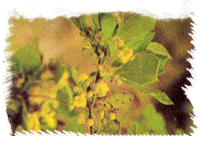 An
erect spinous shrub, 2 - 3 m high, often forming gregarious
patches, pale yellowish brown bark, closely and rather deeply
furrowed. Flowers golden yellow. An
erect spinous shrub, 2 - 3 m high, often forming gregarious
patches, pale yellowish brown bark, closely and rather deeply
furrowed. Flowers golden yellow.
Common names:
Rasaut, Daruhsldi.
DISTRIBUTION
Occurs in the
Himalayas between 2000-3000 m height and also in Nilgirl hills.
Parts used:
root, root bark, stem wood and fruits.
CULTIVATION
Soil and climate
It can be
cultivated in any type of soil. Grows well in temperate climate.
Nursery raising
and planting
Propagation is
from seeds, self-sown is nature. Seedlings or cuttings can be
taken during spring. Season after the berries are over. Seedlings
are transplanted in field at distenceof 100X100 cm.
Thinning and
weeding
Weeding and
thinning of plants may be done as and when required usually after
15-30 days for better growth.
Manure
2q. farm yard
manure (FYM) per acre should be applied. Compost/vermin compost,
organic manure is preferred.
Irrigation
Irrigation may
be done as per requirement weekly/fortnightly.
Harvesting/post-harvesting Operation
The root, stem
bark are removed from mature plant after two years of plantation &
cut in small pieces are dried in shades.
Economics (per
acre-2002)
The rate of 01
kg of bark ranges from RS.40-50.
Uses
Diarrhoea,
dysentery, jaundice, eye problems.
|
|
|
|
GUDMAR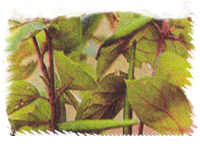
A woody climber
with small yellowish flowers and simple opposite, weight elliptic
hairy leaves. It is found wild in various deciduous forests of
India.
Common names :
Madhunashini, Merasingi and Gudmar Buti
DISTRIBUTION
It is found in
Uttar Pradesh, Madhya Pradesh, Maharashtra, Punjab, Haryana, Tamil
Nadu, Andra Pradesh, Kerala, Karnatka, Bihar and Bengal.
Parts Used :
Leaves and roots
CULTIVATION
Soil And Climate
The plant grows
in a variety of soil and agro climatic conditions in tropical and
sub-tropical regions upto 600 m.
Nursery Rising
and Planting
Mature seeds are
collected between October – December and sown in poly-boxes over
bags or small plots as nursery. The raised seedlings are
transplanted in field during February-March. The plant grows well
with the on-sit of rainy season. The climber is given proper
support for its better growth in development. It can also be
planted in between trees and inter cropping.
The plant can
also be propagated through cutting and planted during rainy
season.
Weeding and
Hoeing
Periodical
weeding and hoeing is required, particularly during and after
rainy season.
Manure
Compost or
Vermicompost is preffered for application while preparing soil for
nursery and in the field plantation.
Irrigation
Periodic
irrigation as and when required may be done weekly/fortnight.
Harvesting/Post-Harvesting
After one year
leaves are ready for harvesting. The leaves are usually collected
during October-February and are cleaned, dried in shades. The
roots are collected during summer and are cleaned, washed and cut
into pieces and dried.
ECONOMICS (Per
Acre, 2002)
Input Cost Rs.
2,500.00
Output Rs.
6,000.00
Yield 4 q
/ leaves
Uses
Hepatospleenomegaly, Jaundice, Diabetes.
|
|
|
|
GUGGAL
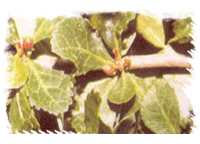 A
shrub or small tree reaching up to 3 to 4 m high. Leaves sessile,
alternate, 1-3 foliate. Plants dimorphic, one having bisexual and
male flowers and other female flowers. Fruit ovoid, drupe. A
shrub or small tree reaching up to 3 to 4 m high. Leaves sessile,
alternate, 1-3 foliate. Plants dimorphic, one having bisexual and
male flowers and other female flowers. Fruit ovoid, drupe.
Common names :
Guggulu & Guggal.
DISTRIBUTION
Found in Karnataka, Rajasthan,
Deccan and Gujrat.
Parts Used :
Olio gum-resin.
CULTIVATION
Soil and Climate
It can be cultivated in sandy to
silt-loam or rocky soils, poor in inorganic matter but rich in
several other minerals. The growth is faster in the soils, which
have moisture-retaining capacity.
Nursery Raising and Planting
The plants are best raised from stem
cutting semi-wood (old) branch. One-meter long woody stem of 10mm
thickness is selected and the cut end is treated with growth
harmone (IBA & NAA) and planted in a well-manured nursery bed
during June-July months; the bed should be given light irrigation
periodically. The cuttings initiate sprouting in 10-15 days and
grow into good green sprout in next 10-12 months. These rooted
plants are suitable for planting in the field during next rainy
season. The cuttings give 80-94% sprouting.
Seed germination is very poor (5%)
but seedlings produce healthier plants, which withstand high
velocity wind.
Thinning and Weeding
The planting does not require much
weeding and hoeing operation. But soil around the bushes should be
pulverized twice in a year to increase the growth.
Manure
Application of 5 kg Farm Yard Manure
(FYM)/plant per year is sufficient.
Irrigation
Requires moderate irrigation. Even a
limited irrigation during summer season improved rate of growth.
Harvesting / Post – Harvesting
Operation
Plants attain normal height and
girth after 8-10 years of growth when they are ready for tapping
of the gum by shallow incision on the bark between December and
March.
Yield
Approximate 500-800 gum per well
grown plant.
ECONOMICS (Per Acre)
Input
Cost Rs. 1,00,000.00
Output Rs. 2,00,000.00
Yield 8 q gum resin
|
|
|
|
JATAMANSI
An erect perennial herb, 10-60 cm in
height, with woody stout, rootstock covered with reddish brown
fibres of the petioles of radical leaves. Leaves radical,
longitudinally nerved; flower pale-pink or blue.
Common Names
: Mamsi, Balchara & Sumbulut-teeb.
DISTRIBUTION
Found in alpine Himalayas from
3,300-5000 m heights. Hills of Himachal Pradesh, Uttaranchal,
Jammu & Kashmir and Sikkim.
Parts Used
: Rhizome
CULTIVATION
Soil and Climate
Sandy loam and acidic soil rich in
organic carbon and nitrogen is found best for germination as well
as for better survival of seedlings and productivity. Moist and
partial sunny areas are found suitable for cultivation. Further
moist rough wall surface provide suitable microhabitat for better
growth. At lower altitude (1800-2200 m) plain beds with slight
tilt (5°-10°) are found suitable for cultivation unlike horizontal
and vertical beds at alpine site.
Nursery Raising and Planting
Seeds are sown during
November-December in polyhouse at lower altitude, during
March-April in open beds at middle altitude and during May in
alphine area. Seedlings are transplanted after six to eight weeks
in the field. At lower altitude root growth as well as number and
length of leaves increases rapidly as compare to higher elevation.
However, fibrous root formation takes only after third year of
growth when, plants are raised by seedlings. About 44,000 plants
are planted in one acre of land.
Vegetative propagation through
splitting of roots is found most successful in Nardostachys
jatamansi and observed better for multiplication as well as for
higher production within a short period than cultivation through
seedlings.
Manure
For cultivation, better survival and
yield of Jatamansi at lower altitude (1800m) 60-70qs manure is
required for one acre of land. However, the results are found best
in litter treatment instead of live stock manure. The sites rich
in organic carbon needed 46-60qs manure per acre for higher yield.
Irrigation and Weed Control
Beds need excessive
watering/irrigation to decrease the mortality rate. Watering
requirement will change in respect of different months like no
irrigation is needed during monsoon period. Watering requirement
also depends on the location of sites and texture of soil. During
the dry season i.e. May-June and September-October watering must
be done at every two days interval at lower altitude. Weeding also
depends on the condition of soil and presence of weeds. Generally
weeding must be done at weekly interval in the first year of
seedling growth and during the second and third year twice in a
month.
Harvesting/Post-Harvesting
Plants should be harvested just
before senescence after maturing to achieve the higher quality of
active contents. With a view to achieve higher amount of
bio-active ingredients, it must be collected during the month of
September at lower altitude while in the month of October at
higher altitude. The harvesting period for this species is 3-4
years; the harvested roots are washed and dried in shade.
Economics
The rate for 1 kg of rhizome/root
ranges from Rs. 150-160.
Uses
Epilepsy, Hysteria, Hypertension,
Erysipelas.
|
|
|
|
KALIHARI
A herbaceous
tendril climber.
Soil Type
: Grows well in red sandy loam soil
Distribution:
Throughout India.
Parts used: Rhizome
Nursery raising and planting: Grown by seeds and tubers,
but plants are best raised from tubers. Tubers are planted in the
bed during rainy season, maintaining 60x60 cm spacing.
Tubers: About 41,500 tubers are required /ha.
Weeding and Horing: Periodical weeding and hoeing is
required.
Manure: 6 Tonnes compost/FYM is required /Acre.
Harvesting: The fruits are harvested after 170-180 days of
planting.
Yeild: 250-300 kg seeds /ha annually and 2.5-3 tonnes/ha
tuberous roots after five years of the plantation.
Economics/Acre
Input cost (Rs)
Output (Rs) Yield
1,50000/-
6,50,000/- 13q seeds/30 q tuber
|
|
|
|
KALMEGH
A bitter annual
herb, 0.5 to 1 m in height. It is also known as Hara-Chiretta.
Widely distributed throughout plains of India from Uttar Pradesh
to Assam, Madhya Pradesh, Tamil Naidu and Kerala.
Nomenclature
Family :
Acanthacear
Genus : Andrographir
Species : Paniculata
USES
Parts Used :
Whole Plant
Uses : Jaundice, wounds, chronic fever
Cultivation
practices
CULTIVATION
Soil and Climate :
It can be cultivated in shady wastelands on wide range of soils.
The climatic requirement of the plant is hot and humid conditions
with ample sunshine.
Irrigation :
Harvesting :
Yield :
LAND PREPARATION
The soil of the field selected for Ashwgandha should used
pulverized by ploughing and harrowing.
NURSERY RAISING AND PLANTING
For raising crop in one hectare three beds of 10 x 2 m size should
be tilled, pulverized and leveled during the month of May. Beds
should be covered properly by suitable mulch and irrigated
regularly. Transplanting of seedling is done in second fortnight
of June at a row and plant spacing of 45 to 60 cm and 30 to 45 cm
respectively.
THINNING AND WEEDING
To begin with one or two weeding / noeing essential to get the
crop established
MANURE
3-6 tones of FYM is required for
raising nursery.
IRRIGATION
2-3 irrigations are required.
HARVESTING
By the end of September.
ECONOMICS PER
ACRE
Yield
: 12 Quintals herbage per acre.
Cost of cultivation, yield and income per acre
|
Input Cost
(Rs) |
Output
Cost (Rs) |
Yield |
|
8,000/- |
12,000/- |
12
Quintals (Herbage) |
|
|
|
|
KESAR
The saffron is a small perennial
herb, 40-45 cm tall. It possesses a somewhat globular corms which
is solid, white, fleshy covered with a series of fibrous sheaths
and 3 to 5 cm in diameter when fully developed. It produces 6 to 9
grass like radical leaves flowers are terminal, reddish purple and
appears during October to November. The androcium consists of 3
stamens, filaments are short, free anthers are yellow and
basifixed.
Common Names : Saffron,
Zafran, Kumkum.
Parts Used : Stigma & Style.
DISTRIBUTION
It is cultivated in Jammu and
Kashmir. Attempts have been made to cultivate it in adjoining
Himalayan, parts of Punjab, Himachal Pradesh and Uttaranchal.
CULTIVATION
Preparation of Land
The plant requires very rich
well-drained, sandy and sandy loam soil for optimum plant growth.
PLANTATION
The corms are planted July-August at
a distance of 5-8 cm from each other in rows, 20 cm apart, at a
depth of 8-10 cm and covered properly with soil. Sixteen to
eighteen quintals of corms are required to plant one acre of land.
MAINTENANCE AND AFTER CARE
To obtain a good crop proper
maintenance of beds and drainage channels etc. are quite
essential. Periodical hoeing and weeding are important for good
yield. Weeding is very essential in rainy season.
IRRIGATION
The beds should be lightly watered
to a soil depth of about 10 cm after planting. Light irrigation
essential during flowering time with an interval of 5-6 days. One
irrigation is given in November-December.
MANURE
Higher floral and corm production
demands 6-7 tonnes of well-decomposed Farm Yard Manure (FYM) per
acre. The FYM application is suitable in the month of July-August.
HARVESTING & YIELD
Picking of flowers on alternate days
during wee hours of morning provides an opportunity to pick
flowers easily and keeps all the quality parameters. Processing is
done by isolating stigma and style and placed for air-drying. One
Kg of Saffron (stigma & style) needs 2-3 days sun drying. Normally
between 1,60,000 to 1,65,000 flowers are required to produce one
kilogram of good quality dried Saffron. The yield of Saffron in
Kashmir is reported to be 1 to 1.5 kg per acre.
ECONOMICS
Initial expenditure to start Saffron
cultivation is quite high due to high cost of planting material.
The net profit thus starts from the third year onwards.
USES
Aphrodisiac, Cardiotonic,
Carminative, Diaphoretic, Diuretic, Emmenogogue, Fabrifuge,
Stimulent, Nerve Tonic, Stomachic.
|
|
|
|
KOKUM
A small to medium sized tree, leaves
simple, dark green, elliptic ovate; flower in fascicles;fruit
ovoid,yellow or red when ripe.
Common names: konkom, amarita,
and vrasamla.
DISTRIBUTION
Found in Maharashtra, Goa,
Karnataka, Kerala, south Gujarat, assam, West Bengal.
Part used: Ripe fruits.
CULTIVATION
SOIL AND CLIMATE
Grown in a variety of soil and in
different agro-climatic conditions.
NURSERY RISING AND PLANTING
Cultivated by soft wood grafting and
planted in the month of June-August.
THINNING AND WEEDING
Weeding and thinning of the plants
may be done as and when required usually 15-20 days.
MANURE
20 kg Farm Yard Manure (FYM) is
required for better crop.
IRRIGATION
Normally grown as rainfed crop.
Hence regular irrigation is not in vogue for grown-up orchards.
HARVESTING/ POST HARVESTING
OPERATION
Harvesting is done in March-April.
Fruits and Bark are removed and dried in shade.
YIELD
Ripe fruit 3 ton per acre.
ECONOMICS (Per Acre – 2002)
Input Cost
Rs. 7,000.00
Output
Rs. 35,000.00
Yield 3T
USES
Hemorrhoids, Diarrhoea, Dysentery,
Dyspepsia, Hyperdipsia.
|
|
|
|
KUTH
A robust erect, perennial plant with
large leaves. Roots stout up to 60 cm long and used medicinally.
Flowers & fruits – August-September; seeds collected during
September – October.
Common names
: Kuth, Kustha.
DISTRIBUTION
Distributed and found in Himachal
Pradesh, Uttaranchal, Uttar Pradesh, Jammu & Kashmir, Sikkim &
Arunachal Pradesh.
Part Used :
Tuberous Root.
CULTIVATION
Soil and Climate
: Sandy textured loam soil, rich in moisture and organic carbon is
best for germination as well as better survival of seedlings and
productivity. The plant grows in temperate and sub-alpine region.
Planting :
Cultivation and nursery of Kuth in ‘Bio-edaphic condition at an
altitude of 1200-1800 m is suitable. The seeds are sown in April
or May in nursery. When the seedlings are ±15 cm long, these are
transplanted in fields.
Irrigation
The crop requires 5-6 irrigations
between May-September. The land is irrigated when seeds are
sprouting.
Manure
Well-decomposed farmyard manure @
2-3 q/acre should be applied to nursery beds and in the field at
the time of field preparation.
Harvesting / Post-Harvesting
Usually in 2-3 years well-grown
mature root tubers are developed. However, yield is obtained from
3 years old crop. Root is harvested in early September or October
or early spring. The roots are cleaned with water and dried for
processing.
Yield
After 2-3 years of planting about
200-250 kg. of dry tuberous roots per acre can be obtained. The
market rate is Rs. 80-90 per kg.
Economics (Per acre)
Input
cost Rs. 10,000.00
Output Rs. 20,000.00
Yield 2 q
Uses
Chronic and Foulucers, Odontalgia,
Cough, Asthma, Hiccough, General Debility.
|
|
|
|
MAKOY
An erect herb 30-60 cm high with
small white flower and green berries (fruits) turns red or black
or ripening. Seeds discoid, smooth yellowish. Flowering &fruiting-
August to October. It grow as a weed thought out dry parts of
India.
Common names:
Gurkkamai, kakamaci, black nightshade, mako, inabus salab.
DISTRIBUTION
Thought out dry parts of India up to
800 m altitude.
Parts used:
Whole plants and fruit.
CULTIVATION
SOIL AND CLIMATE
The plants grows in different kinds
of soil including dry, stony, shallow or deep soils. It usually
grows in wastelands as weed. It can be cultivated in tropical and
sub- tropical agro-climatic regions.
NURSARY RAISING AND PLANTING
The seeds are snow during April –May
in well manured nursery beds. It takes about 15-30 days to grow.
The seedling are developed in about 15-30 days after sowing. The
seedling are transplanted in rows and 60 X 60cm apart in the
well-prepared field.
WEDDING AND HOEING
Periodic hoeing is done, both in the
nursery and field as per requirement.
IRRIGATION
The nursery beds are plantation
should be irrigated periodically as and when required weekly or
fortnightly. The plants are irrigated till it flowers.
Harvesting / post-harvesting
The crops is usually ready for
harvesting after 4-6 months depending upon the climate and soil.
The plants are collected and dried in shades.
ECONOMICS (PER ACRE)
Input cost (RS.)
output (RS.) yield
5,500 18,000
5 q herbage
USES
Hepatomegaly, vomiting, dropsy,
general debility.
|
|
|
|
MUSKDANA
Soil Type
: Sandy
Sowing
: Plough the field in fully.
Sowing is done in monsoon.
Mannuring
: FYM
Harvesting
: December
Profits :
Rs. 20,000/- per Acre
|
|
|
|
PIPPALI
A glabrous under-shrub with erect or
sub-scandent nodose stem and slender branches. Leaves are simple,
alternate, stipulate and petiolate or nearly sessile. Flowering is
nearly through out of the year; inflorescence spike; fruit grayish
green or darker grey berries.
Common Names: pippali, pipli
& long peper.
DISTRIBUTION
A native of indo-Malayan religion.
It grows wild in the tropical rain forests of India.
Parts used: dried spikes and
roots.
CULTIVATION
Soil and climate
Long pepper can be cultivated
successfully in organic matter rich fertile, well-drained forest
soils. Laterite soils with high organic matter content and
moisture holding capacity are also suitable for cultivation.
Optimum elevation for its cultivation is between 100 to1000m.
Higher elevations are not conducive to high yields. It needs
partial shade 20-25% shade intensity is found to be optimum.
LAND PREPATION
The area should be ploughed 2 –3
times and leveled properly. Raised beds of size 3x2.5m are
prepared and pits are dug at a distance of 60x60cm and dried
cow-dung or farmyard manure at the rates of 100g per pit is
applied and mixed with soil. Two rooted cutting or suckers with
roots and planted in each pit. To avoid any water stagnation in
beds . Channels are laid out to drain excess rainwater.
NURSERY RAISING AND PLANTING
It is propagated by suckers are
transplanted soon after the setting in of monsoon rains. The best
time for raising nursery is during March and April to avoid
mealy-bug attack on roots, 10% DP is to be mixed with the potting
mixture. Normal irrigation may be given on alternate days. Excess
moisture in the nursery can cause phytophthora wilt. By the the
end of May, the cutting will be ready for planting.
THINNING AND WEEDING
In first year regular weeding should
be done as and when the weed growth is noticed in beds.
MANURE
Long pepper needs heavy manuring. In
soils with low fertility, the growth of the plant is very poor.
Eight toners of cow-dung or farmyard manure are required for an
acre of land. Since the crop will give economic yield for 3 years,
the manuring has to be done each year.
IRRIGATION
Irrigation once in a week is
necessary an intercrop and if the main crop is irrigated no
additional irrigation is necessary for pippli, (piper longum).
When the crop is not irrigated, it is necessary to give mulch with
dry leaves or straw during summer months. If the crop is irrigated
during summer, it continues to produce spikes and doff-season
produce will be available.
HARVESTING/POST-HARVESTING
OPERATION
The vines start bearing six months
after planting. The spikes thus will be ready for harvest after
two months since formation of spikes. When the spikes are full
grown but unripe, these are gathered. If left with picking, they
ripe and their pungency is lost to a great extent.
Harvested spikes repeatedly exposed
in the sun for 4 to 5 days until they are perfectly dried. The
dried spikes have to be stored in moisture proof containers.
Thicker parts of lower steams/roots are cut and dried for
producing piplamool. There are three grades of Piplamool.
YIELD
The yield of dry spike during first
year is around 200 Kg/acre it increases upto 500 Kg/acre in the
third year. After third year, the vines become less productive and
should be replanted.
ECONOMICS
Input
Cost Rs. 25,000.00
Output
Cost Rs. 50,000.00
Yield
2.5 q Spikes/ 1 q root
USES
Dyspepsia, Abdominal Pain,
Splenopathy, Anorexia, Asthma, Fever, Haemorrhoids, Digestive,
Appetiser.
|
|
|
|
SARAPGANDHA
An erect evergreen, perennial
under-shrub, 75 cm to 1 m in height. Root is prominent, tuberous,
usually branched, 0.5 to 2.5 cm in diameter. Up to 40 to 60 cm
deep into soil. The roots possess high alkaloid concentration.
Common Names : Candrabhaga,
Chota chand, Serpentina root, Chandrika & Asrol
DISTRIBUTION
Foot hills of Himalayan range, up to
the elevation of 1300-1400 m and almost all over the country.
Lowers hills of Himachal Pradesh, Uttaranchal, Uttar Pradesh, and
Jammu & Kashmir, etc.
Part Used : Root.
CULTIVATION
Soil and Climate
The plant requires slightly acidic
to neutral soils for good growth with medium to deep well drained
fertile soils. Clay-loam to slit-loam soils, rich in organic
content are suitable for its commercial cultivation. It grows well
in frost-free tropical to sub-tropical situation under irrigation.
Nursery Raising & Planting
The crop can be propagated by seed,
stem cutting and root cuttings. Seed propagation is the best
method for raising commercial plantation.
Manure
Farm Yard Manure at (10 to 12
q/acre) is required for land preparation has given good response
by the crop.
Irrigation
Rauwolfia, if grown in the areas
which receive rainfall of 150 cm or above well distributed
throughout the growing season such as in Assam and Kerala, can be
raised and rainfed crop under subtropical conditions. It is
suggested that 15 to 16 irrigations, at 20 days interval in summer
and at 30 days interval in winter are sufficient.
Weeding
The Rauwolfia field should be kept
relatively weed-free in the early period of growth. This means
giving two to three weedings and two hoeing in the first year
where sole Rauwolfia crop is taken or 5-6 weeding where intercrops
in Rauwolfia are practised.
Harvesting/Post-Harvesting
Root yields at different age and
climate has shown that 18 months duration crop produce maximum
root yield. Transplanting is done in July; the harvesting period
coincides with the shedding of leaves during early autumn season
next year. At this stage, the roots contain maximum concentration
of total alkaloids. At harvest the root may be found to go up 40
cm deep in the soil.
After digging the roots are cleaned,
washed and cut into 12 to 15 cm pieces for convenience in drying
and storage. The dry roots possess upto 8-10 per cent of moisture.
The dried roots are stored in polythene lined gunny bags in cool
dry place to protect from mould.
Yield
On an average, root yield vary from
6 q/acre of dry weight under irrigation depending upon soil
fertility, crop stand and management.
Economics (Per acre)
Input Cost (Rs.)
20,000.00
Output (Rs.)
40,000.00
Yield 6 q root
Uses
Hypertension, Insomnia, Epilepsy,
Fever, Cardiac Problems, Palpitation.
|
|
|
|
SHATAVARI
A perennial, prickly climber excessively branched,
Roots tuberous 15-40 cm long, grayish-white and cultivation both
for medical and ornamental purpose.
Common names:
Satamuli, Satavar, Abhiru&Satavari.
DISTRUBATION
Found thought
out INDIA in the topical& sub-topical parts up to 1200m wild or
cultivated.
Part used:
Tuberous roots.
CULTIVATION
Soil and climate
Plant usually
grows in a variety of soils including medium black heaving
pH7-8,it can be easily grown in sub- topical &sub-temperate agro-
climate religious up to 1400m.
LAND PREPARATION
The soil is given 20-30 cm deep ploughing followed by 2-3
harrowing after few days. Grasses and weeds are removed. The land
is properly leveled and 40-45 cm broad ridges are prepared for
plantation, leaving 15-20 cm furor space as channel for
irrigation.
Nursery raising
and planting
Seeds are sown
in April in raised beds at 5cm a part to facilitate decay of its
hard seeds coat by the time monsoon commence. Germination stars in
8-10 days after the first shower of monsoon in June. The seedling
are transplanted on ridges at 60X60 cm a part and provided bamboo
stakes when the plants attained a height of 45cm.
Vegetative
propagation is by division of rhizomatous disc present at the base
of the aerial stem. The rhizomatous disc develops several
vegetative buds around the aerial shoot. The disc is divided in
such a way that each piece possessed at least two buds along with
2-3 tuberous roots. These pieces are planted, covering the buds
with 1cm of soil followed by irrigation. The sprouting commences
in 8-10 days after plantation.
Weeding
Two weeding are
carried out during the rainy months, therefore one in n Irrigation
ext 2-3 months.
Irrigation is
done after the rainy season is over, at the rate of two
irrigations in winter season and one per month in summer season.
Manure
FYM used for
better crop produce.
Harvesting/Post-Harvesting
The plants are
harvested after 40 months in winter. The roots are dug-out
collected and cleared. The roots are peeled off with the help of
sharp knife immediately after harvesting. It is observed that in
case the roots are not peeled of within a few days, it is a bit
difficult to remove the skin as such. In such a conditions the
roots are kept in boiling water for about 10 minutes, followed by
cold water treatment of facilitate peeling. After removing the
skin, it is cut transversely into small pieces and dried in
shades.
Yield
Estimated yield
of 35 q/acre dry roots in reported.
Economics (per acre)
Input cost (RS)
25,000
Output
(RS) 70,000
Yield 35q root
Uses
Nervous
Disorders, Burning Sensation, Thirst, Cough, Tuberculosis, General
Weakness, Aphrodisiac, Enhance Lactation.
|
|
|
|
TULSI
An annual plant, 30-60 cm high, much
branched; stem and branches usually purplish, sub-quadrangular;
leaves 2.5-5 by 1.6-3.2 cm, elliptic oblong-obtuse, pubescent on
both side and minutely gland-dotted. Flowers in racemes.
Common Names
: Holy Basil, Krishna Tulsi.
DISTRIBUTION
Found all over the country.
Parts Used
: Leaf, Whole plant, Seed.
CULTIVATION
Soil and Climate
Thrives well on variety of soils.
Rich loam to poor laterite, saline and alkaline to moderately
acidic soils are well suited for its cultivation. Well-drained
soil helps better vegetation growth. Water logged condition can
cause root-rot and result in stunted growth.
The plant can be grown under
partially shaded conditions but with low oil contents. It
flourishes well under fairly high rainfall and humid conditions.
Long days and high rainfall and humid conditions. Long days and
high temperatures have been found favorable for plant growth and
oil production. Topical and sub-topical climate (at altitudes upto
900m.) is suited for its cultivation.
Land and Preparation
The land is brought to fine tilth
and laid out into plots of convenient sizes for irrigation. It is
preferable to add 6 tonnes of farmyard manure per acre during the
preparation of land and mixed well in the soil.
Nursery Raising and Planting
The nursery can be raised in the
third week of February and transplanting is generally started in
the middle of April. The plant is propagated by seeds. Raised seed
beds of 2-3 m x 5 m long should be throughly prepared and well
manured by addition of farmyard manure. About 200-300 g seeds are
enough to raise the seedlings for planting one hectare of land.
The seed should be sown 2 cm below in the nursery beds. The seeds
germinate in 8-12 days and the seedlings are ready for
transplanting in about 6 weeks time 4-5 leaf stage. The seedlings
are transplanted at 40 x 40 cm and 40 x 50 cm to get high herbage
and oil yield per acre.
Weeding and Hoeing
First weeding is done one month
after planting and the second 4 weeks after the first. One hoeing
after two months of planting is sufficient.
Manure
Compost/Vermi compost and organic
manure is preferred.
Irrigation
Irrigation depends upon the moisture
content of soil. In summer 3 irrigations per month are necessary,
in rainy season no irrigation is required.
Harvesting/ Post-Harvesting
Operation
The crop is harvested is obtained at
90-95 days of planting. Then it may be harvested every 65-75 days
interval. Harvesting is done usually on bright sunny days for good
oil yield and its quality. It is not desirable to harvest the crop
if there was a rain in the previous day.
Yield
About 2 tonnes of fresh herbage can
be obtained twice or thrice a year per acre.
Economics (Per acre)
Input Cost (Rs.)
2,000.00
Output (Rs.)
5,000.00
Yield
2 tones herbage
Uses
Fever, Asthma, Bronchitis, Vomiting,
Cough, Expectorant.
|
|
|
|
VAIVIDANG
A large scandent shrub with elliptic lanceolate leaves; flowers
small white of greenish –white; fruits are small rounded red to
blackish, striated, 3-4 mm berries. Flowering March – April and
fruiting June – October.
Common names:
Bhabhirang, Vidangah & Baobarang.
DISTRIBUTION
Hills of eastern
India in Assam, Bengal, Orissa, Bihar, Madhya Pradesh, and through
out North India.
Part used:
Fruit.
CULTIVATION
Soil and
climate
The plant can be
grown in a variety of soils including light black cotton soil,
sandy/rocky in different agro- climatic conditions in topical
regions up tp 800-1500 m altitude.
Nursery
Raising and Planting
The seeds are
sown in well – prepared nursery beds in May-June. About 5 k/g
seeds are required for preparing 10,000 plants, which are
sufficient for one acre of land. The seedlings of 6 months are
transplanted in to the heavily manured field at a distance of
60X60 cm. The seedling can also be planted in pits of 1X1 feet
size.
Manure
Compost/vermin
compost, Orognic manure in preferred.
Weeding
Weeding and
thinning of plants may be done as and when required usually after
15-30 days for better growth of the plants.
Irrigation
The plantation
can be irrigated usually at an interval of 15 days.
Harvesting/
Post-Harvesting
Harvesting is
done after two years. Generally fruiting starts in
August-September after 2 years of plantation and fruit ripes
during November to January. The fruits are collected, dried in
shade and stored in clean porous Jute-bags. The fruits are
collected manually and the plant is allowed to grow further.
Yield
The produce (dry
fruits) of about 10 q/acre can be collected.
Economics (Per/acre)
Input
Cost Rs. 35,000.00
Output Rs.
1,00,000.00
Yield 10 q
fruit
Uses
Helminthiasis,
skin diseases.
|
|
|
|
VATSNAB
A perennial herb
with tuberous roots 50-100cm high with an erect stem; leaves
semi-circular, flower blue, in loose racemes. Roots are dark-brown
externally and on tasting. It produces strong tingling sensation.
Common names
:mithavis and vatsanabhah.
DISTRIBUTION
Himachal
Pradesh, Uttaranchal, Jammu & Kashmir and Sikkim.
Part used:
Roots.
CULTIVATION
Soil and
Climate
Sandy textured
loam soil, rich in moisture, humus and in organic carbon between
2000-3000 m altitude near snow line usually on slopes is
preferred. It requires temperate to sub-alpine area. The land for
planting may be sloppy with raised beds in between furrows like
potato cultivation.
Nursery
Raising and Planting
Seeds are sown
during February-March about 3-4 cm deep in the soil and 10-15 cm
apart in the raised nursery beds. Five hundred to eight hundred
grams seeds in one hectare are sufficient. The
sprouting/germination of seeds should be protected from frost.
About 5-10 cm long seedlings are suitable for transplantation in
the field. The pieces of root tubers (root-stocks) with growing
buds can also be planted directly in the field during May-June.
Manure
Compost/vermin-compost or organic manure is preferred.
Irrigation
Irrigation may
be done till flowering or fruit setting is there, usually
intermittently as per requirement (weekly/fortnightly)
Weeding
Weeding of
plants may be done as and when required usually after 15-30 days
for better growth of the plant.
Harvesting/Post-Harvesting
The mature root
tubers after completion of reproductive (Flowering/Fruiting) phase
are ready for collection with in three years of planting. However,
it is observed that maximum active ingredients are found during
July-August at the time of initiation of flowering period. Thus
during this period plants can be harvested to achieve high quality
of active contents. The collected tubers are cut into small
pieces, dried in shade and stored in cool moisture free dry
containers.
Economics
(Per Acre)
Per acre
production from mature stands in natural pockets in estimated as
250 kg. the rate for 01 kg of roots ranges from Rs. 100-130.
Uses
Cephalgia,
Neuralgia, Cardiac Debility, Leprosy, Skin Diseases, Paralysis,
Fever.
|
|
|
|
MILK
THISTLE (Plant that Heal)
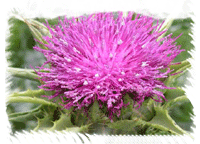 Scientific
Names : Silybum marianum (L.) Gaertner Scientific
Names : Silybum marianum (L.) Gaertner
Synonyms : Carduus
marianus L.; Cnicus marianus, C. benedictus
Family :
Asteraceae (Compositae)
Common Names : Milk Thistle,
Variegated Thistle, Wild Artichoke; Mary Thistle, St. Mary
Thistle, Marian Thistle, Lady's Thistle, Holy Thistle (Born 1996;
Foster, 1990; Anonymous, 1985); Marienistel fruchte (German)
(Blumenthal Et Al., 1998)
DESCRIPTION
OF PLANT
The Silybum genus contains two
species: S. marianum (L.) Gaertner and S. eburneum. Both species
are indigenous to the mediterranean region, although Kashmir is
considered the native home of S. marianum (Morazzoni and
Bombardelli, 1995).
Silybum marianum is a
persistent herbaceous annual or biennial eaisly recognized by its
stout thistle, reddish-purple flowers, large prickly leaves with
milky white zones, and tubular-shaped flowers that terminate in
shape pines (A Snonymous, 1985).The glabrous stem varies widely in
height (20-150 CM high) and the upper part of the stem is erect
and branched. The large glabrous white-veined leaves have a
distinct spiny margin. the brownish-colored fruits are hard
skinned any shiny, average 6-8 mm in length, and display a white
silk-like pappus at the apex (Morazzoni and Bombardelli, 1995).
In many regions, milk thistle
(S. marianum) is a widespread way side herb. throughout Europe and
north America, milk thistle is often found in wastelandes, along
roadsides, and on cultivated ground. The distribution of S.
marianum ranges from the sea to submountainous areas, where it
grows in altitudes up to 700-1 , 100 m (Marazzoni and Bombardelli,
1995), European colonists reportedly transported the herb to the
new word from Britain (Pickering, 1879, in Foster, 1990), and it
has since become naturalized in the eastern United States,
California, and parts of Canada. Milk thistle also grows in India,
China, South America, Mexico, Australia, and Africa (Foster, 1990;
Anonymous, 1985). Milk thistle has very few predators and matures
in less then one year, flourishing best on well-draining soils and
in sunny areas (Foster, 1990).
TRADITIONAL
USES
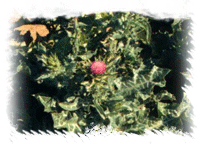 Silybum
marianum is an edible plant; despined, the leaves are eaten much
the same way as artichokes. The seeds, when roasted, can be brewed
as a coffee substitute. Historically, the favorful leaves and
roots of this species were eaten as foods and occasionally
employed in madicinal preparations (Morazzoni and Bombardelli,
1995). In Europe, milk thistle was cultivated in gardens both as a
vegetable and an ornamental plant (Foster, 1990). Silybum
marianum is an edible plant; despined, the leaves are eaten much
the same way as artichokes. The seeds, when roasted, can be brewed
as a coffee substitute. Historically, the favorful leaves and
roots of this species were eaten as foods and occasionally
employed in madicinal preparations (Morazzoni and Bombardelli,
1995). In Europe, milk thistle was cultivated in gardens both as a
vegetable and an ornamental plant (Foster, 1990).
The genus name Silybum is from
the Greek sillybon: a tuft or pendant. The oldest known mention of
Silybum as a medicinal plant was by legendary Greek physician
Dioscorides, who coined the name to describe a thistle whit
white-blotched leaves. he prescribed the roots of . marianum as an
emetic, and with the leaves he made a decoction to treat
snakebites (Marazzoni and Bombardelli, 1995; Hobbs, 1984).
Bingel and Farnsworth (1994)
list galactogogue use of the seed in England and the root or seed
in Italy. John Evelyn wrote "Disarmed of its prickles and Boiled,
it is worthy of esteem, and thought to be a great breeder of milk
and proper diet for women who are nurses" (Grieve, 1980, p. 797).
To followers of the Doctrine of signatures, the white blotches on
the leaves would likely indicated its utility as a galactogogue.
one legend relates that while nursing the infant Jesus, the virgin
Mary spilled a drop of her Brest milk on the leaves, Which forever
after gave them their characteristic white veins. Still other
legends appear to stem from an older, pre-Christian goddess myth
when milk thistle was called Venus thistle and delicate to the
Norse goddess Freya ( Marazzoni and Bombardelli, 1995).
In the fourth century B.C
Theophrastus Spoke of S. Marianum, as did Dioscorides and Pliny in
the first century A.D. During the middle ages, herbalists used
several different parts, including the root and aerial parts, to
treat swellings and erysipelas. The nineteenth-century British
herbalist, Culpeper, recommended S. marianum for melancholy
diseases, which at that time would include liver or bile-related
diseases (including obstructions of liver and spleen). Hobbs
(1984) recounts that Culpeper used an infusion of the fresh root
and seeds to treat jaundice.
In the United states, the
eclectic physicians of the late nineteenth and early twentieth
centuries prescribed remedies made from S. marianum for varicose
veins, menstrual-related pelvic congestion, and congestion of the
liver, spleen, and kidneys, Topical application of the decoction
was claimed to be of benefit in treating cancer. For these and
others diseases, a tincture taken in a dose of five drops was
prescribed by naturopathic doctors. Tinctures made from the seeds
are still used to treat liver ailments, including jaundice,
gallstones, peritonitis, hemorrhage, bronchitis, and varicose
veins (Anonymous, 1985; Schauenberg and Paris, 1974). In France,
the fruits, roots, and leaves of S. marianum are employed in
remedies for the variety of related complaints: chronic
constipation associated with jaundice, bile stones, hepatitis, and
steatosis. Decoctions and tinctures of the fruits are though to
have therapeutic effects on the circulatory system, particularly
hemorrhoids, vericose veins, hay fever, asthma, and nettle rash.
In Italy, the fruits are used in treatment of hepatic
complications such as oliguresis and hypotension. in Germany and
Hungary, decoctions and tinctures are used against
cholangiopathies, bile stones, and liver problems. in Greece,
various plant parts are used to make remedies for vericose veins,
cholelithiasis, duodenal ulcer, amenorrhea and hepatic-related
chronic constipation (Marazzoni and Bombardelli, 1995). Several
Thistles have been traditionally used in herbal remedies for liver
ailments; however, only S. marianum contains silymarin, a complex
of flavonoid, like compounds with demonstrable therapeutic effects
(Hobbs, 1984).
Milk thistle is widely
recommended today by physicians in Europe as both a protective and
restorative agent for liver damage resulting from hepatits,
alcoholism, cirrhosis, and damage due to pharmaceutical drugs,
anesthetics, and Amanita mushroom poisonings, is addition, the
silymarin complex is prescribed by many European practitioners for
various symptoms of sub clinical liver diseases linked to
environmental toxins. Among the various symptoms of environment
liver disorders that silymarin reportedly mitigates are; low
energy postprandial sleepiness, depression, irritability,
headaches, allergies, poor digestion, and acne (Foster,
1990;Hobbs, 1984; Marazzoni and Bombardelli, 1995 ).
CHEMISTRY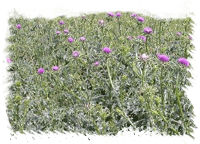
Lipid Compounds :
The lipid fraction comprises
20% to 30% of fruits; of this,52% to 53% is linoleic acid. in the
saponifiable fraction, B-sitosterol has also been identified (Marazzoni
and Bombardelli, 1995).
Phenolic Compounds :
Flavonoids
The seeds contains the
flavonoids quercetin, texfolin, and dehydrokaempferol (Marazzoni
and Bombardelli,1995 Hobbs, 1984;)
Lignans
Flavonolignans in the plant,
generally called silymarin, are the main active constituents.
Flavonolignan-like substances found i the seeds include
dehydrosilybin, desoxysilydianin (silymonin), silyhermin,
neosilyhermin, silandrin, and silybinome (Awang. 1993; Rumyantseva,
1991; wagner et al., 1974). The seeds contains the highest
concentrations of silymarin. Higher quantities are typically found
in specimens from southern, subtopical areas (hobbs, 1984).
Silymarin is an umbrella term
coined in 1968 by Wagner and colleagues to describe the entry
group of active flavonolignan principle found only in the seeds of
S. marianum. Silymarin consists of three isomers: silibinin
(formerly silybin), silydianin, and silycristin (a.k.a. sildianin
and silicristin, resectively). silibinins a and b are
diastereoisomers (Tittel and Wagner, 1977; Wagner et. al., 1974).
The primary flavonolignan in the silymarin complex, silibinn a,
consist of a benzodioxane grouping drived from the coupling of
taxifolin with coniferlyl alcohol ( Marazzoni and Bombardelli,
1995 ).
Gas-liquid chromatographic
analysis of extracts of S. marianum yeilded 2, 3-dehydrosilybin,
as well as silibinin oligomers and dehydrodiconiferyl alchol
(Wagner et.al., 1974). Three other flavonolignans
(3-deoxy-flavonones) have been identified. In addition, studies
show that the presence and concentration of active principles can
vary by geographical region. For example, white-blooming
varietal species of S. marianum have yeilded new compounds:
silymonin (3-deoxy-silydianin) and silyandrin (3-deoxy-isosilybin)
( Marazzoni and Bombardelli, 1995). |
|
|
|
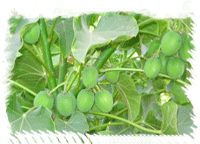 JATROPHA
Family:
Euphorbiaceae (spurge family)
Common Names: peregrina, spicy jatropha
Jatropha curcas (Kattamanakku) is an oil plant. The botanic name
Jatropha is derived from Greek, "Jatras" meaning Doctor and "trophe,"
Nutrition.
One of the
main crops currently being promoted for biodiesel production in
several countries, globally, is Jatropha curcas. There have been
substantial political and social pressures to promote the growing
of such crops (in particular Jatropha curcas) in India, as a means
of economic empowerment, social upliftment and poverty alleviation
within marginalized communities.
Jatropha is a
valuable multi-purpose crop to alleviate soil degradation,
desertification and deforestation, which can be used for
bio-energy to replace petro-diesel, for soap production and
climatic protection, and hence deserves specific attention
Jatropha can help
to increase rural incomes, self-sustainbility and alleviate
poverty for women, elderly, children and men, triabal communities,
small farmers. It can as well help to increase income from
plantations and agro-industries.
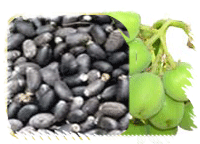 Government
of India has selected the plant for National Program compared to
others due to followings: - Government
of India has selected the plant for National Program compared to
others due to followings: -
- Low cost seeds
- High oil content
- Small gestation period
- Growth on good and
degraded soil
- Growth in low and high
rainfall areas
- Seeds can be harvested
in non-rainy season
- Plant size is
making collection of seeds more convenient
Of all the
above prospective plant candidates as bio-diesel yielding sources,
Jatropha curcas is standing "at the top" and "sufficient
information " on this plant is already available
Description
Peregrina is an evergreen shrub or small tree with glossy
leaves and clusters of star shaped bright scarlet or vermilion
flowers. The plant has a rounded or narrow domed form and gets up
to 15 ft (4.6 m) tall with a spread of 10 ft (3.1 m) or so,
although in cultivation it is usually smaller. Peregrina often
grows shrublike with several slender trunks, but it can be pruned
to a single trunk. The leaves are extremely variable; they may be
entire and elliptic or oval, or they may be fiddle shaped, or they
may have three sharp pointed lobes. They are bronze when young and
brownish on the undersides. The flowers are about 1 in (2.5 cm)
across and borne in multi-flowered terminal clusters almost all
year round. 'Compacta' is a smaller, more compact cultivar.
Culture
Peregrina is tolerant of a wide variety of soils so long
as they are well drained. Peregrina blooms on the current year's
growth so it can be pruned at any time of the year. It handles
pruning well and can be kept to shrub size, trained to a tree form
or used in espalier.
Light: Full sun to partial shade.
Moisture: Peregrina is drought tolerant.
Hardiness: USDA Zones 10 - 11. Peregrina is damaged by
frost and is considered marginal in zones 9B and 10A.
Propagation: Propagate from cuttings taken in spring.
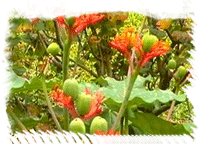 Usage Usage
Peregrina is a spectacular shrub in bloom, which is most
of the year. Use it as an
accent or in a mixed shrub border. Peregrina is not salt tolerant,
but it is tolerant of poor and dry soils. Peregrina makes a fine
container plant on the patio or at poolside. It attracts
butterflies and hummingbirds as well as rave reviews from
passersby.
Features
Jatropha is a very diverse genus which includes cactus
like succulents, herbaceous perennials, and woody trees. They are
all united in the same genus because their very similar flower
structures suggest a relatively recent common ancestor. Coral
plant (J. multifida) is a close relative that is also showy and
used in Zone 10+ landscapes.
|
|
|